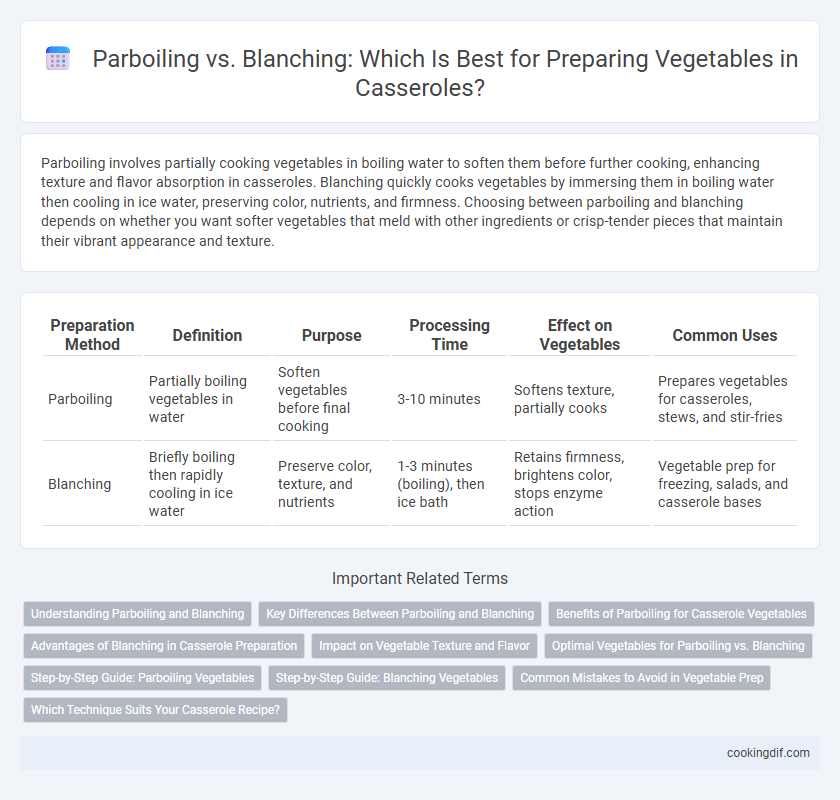Parboiling involves partially cooking vegetables in boiling water to soften them before further cooking, enhancing texture and flavor absorption in casseroles. Blanching quickly cooks vegetables by immersing them in boiling water then cooling in ice water, preserving color, nutrients, and firmness. Choosing between parboiling and blanching depends on whether you want softer vegetables that meld with other ingredients or crisp-tender pieces that maintain their vibrant appearance and texture.
Table of Comparison
| Preparation Method | Definition | Purpose | Processing Time | Effect on Vegetables | Common Uses |
|---|---|---|---|---|---|
| Parboiling | Partially boiling vegetables in water | Soften vegetables before final cooking | 3-10 minutes | Softens texture, partially cooks | Prepares vegetables for casseroles, stews, and stir-fries |
| Blanching | Briefly boiling then rapidly cooling in ice water | Preserve color, texture, and nutrients | 1-3 minutes (boiling), then ice bath | Retains firmness, brightens color, stops enzyme action | Vegetable prep for freezing, salads, and casserole bases |
Understanding Parboiling and Blanching
Parboiling involves partially cooking vegetables in boiling water to reduce overall cooking time and soften textures, which is ideal for casseroles requiring even cooking. Blanching briefly immerses vegetables in boiling water followed by rapid cooling in ice water to preserve color, flavor, and nutrients, enhancing the visual appeal and freshness of casserole ingredients. Both techniques improve texture and nutrient retention but differ in cooking duration and purpose within vegetable preparation.
Key Differences Between Parboiling and Blanching
Parboiling involves partially boiling vegetables to soften them slightly, enhancing texture and reducing cooking time in casseroles, while blanching quickly boils vegetables followed by immediate cooling in ice water to halt cooking, preserving color and nutrients. Parboiling is typically longer in duration, making it suitable for tougher vegetables like potatoes, whereas blanching is brief, ideal for delicate vegetables such as green beans to maintain crispness. The key difference lies in their purpose: parboiling prepares vegetables for further cooking, and blanching is used mainly for preservation and color retention.
Benefits of Parboiling for Casserole Vegetables
Parboiling vegetables for casseroles partially cooks them, ensuring even heat distribution and a tender texture without overcooking during baking. It preserves nutrients and enhances the vegetables' natural flavors by quickly heating them through. This method reduces overall cooking time, making casserole preparation more efficient and consistent.
Advantages of Blanching in Casserole Preparation
Blanching vegetables for casserole preparation enhances color retention, texture, and flavor by briefly boiling then rapidly cooling them, which stops enzymatic activity and preserves nutrients. This process reduces cooking time in the casserole, ensuring vegetables remain crisp and evenly cooked without becoming mushy. Blanching also prevents oxidation and improves the overall visual appeal and taste of the final dish.
Impact on Vegetable Texture and Flavor
Parboiling softens vegetables while retaining some firmness, which enhances texture in casseroles by preventing overcooking during baking. Blanching briefly cooks vegetables, preserving crispness and bright color, leading to a fresher flavor profile in the final dish. Choosing parboiling or blanching directly influences the balance of tenderness and flavor intensity in casserole vegetables.
Optimal Vegetables for Parboiling vs. Blanching
Parboiling suits denser vegetables such as potatoes, carrots, and green beans to soften them partially before incorporating into casseroles, preserving texture during baking. Blanching works best for crisp vegetables like broccoli, asparagus, and peas, quickly halting enzyme activity to maintain vibrant color and crunch. Proper selection between parboiling and blanching enhances vegetable quality and dish consistency in casserole preparations.
Step-by-Step Guide: Parboiling Vegetables
Parboiling vegetables involves partially boiling them in water for a brief period, typically 3 to 5 minutes, to soften without fully cooking. Start by bringing a large pot of water to a rolling boil, then add the vegetables and cook until they are slightly tender but still firm. Immediately drain and plunge the vegetables into ice water to stop the cooking process, preserving their color and texture for casserole preparation.
Step-by-Step Guide: Blanching Vegetables
Blanching vegetables involves briefly boiling them in water for 1-3 minutes, then rapidly cooling them in ice water to halt the cooking process. This technique preserves vibrant color, crisp texture, and essential nutrients, ideal for casserole vegetable prep. Parboiling, in contrast, partially cooks vegetables but lacks the rapid cooling step, making blanching superior for maintaining optimal vegetable quality.
Common Mistakes to Avoid in Vegetable Prep
Parboiling and blanching are often confused, leading to overcooked, mushy vegetables in casseroles. Avoid using boiling times that are too long for delicate vegetables, which can cause loss of texture and nutrients. Ensure rapid cooling after blanching to preserve color and stop the cooking process, preventing soggy casserole ingredients.
Which Technique Suits Your Casserole Recipe?
Parboiling partially cooks vegetables by boiling them briefly, making it ideal for casseroles requiring tender, fully cooked ingredients by the time of baking. Blanching involves boiling vegetables for a short time followed by immediate cooling to preserve color and texture, perfect for casseroles where vegetables need to stay firm or retain vibrant appearance. Choosing between parboiling and blanching depends on the desired vegetable texture and cooking time of your casserole recipe.
Parboiling vs blanching for vegetable prep Infographic

 cookingdif.com
cookingdif.com